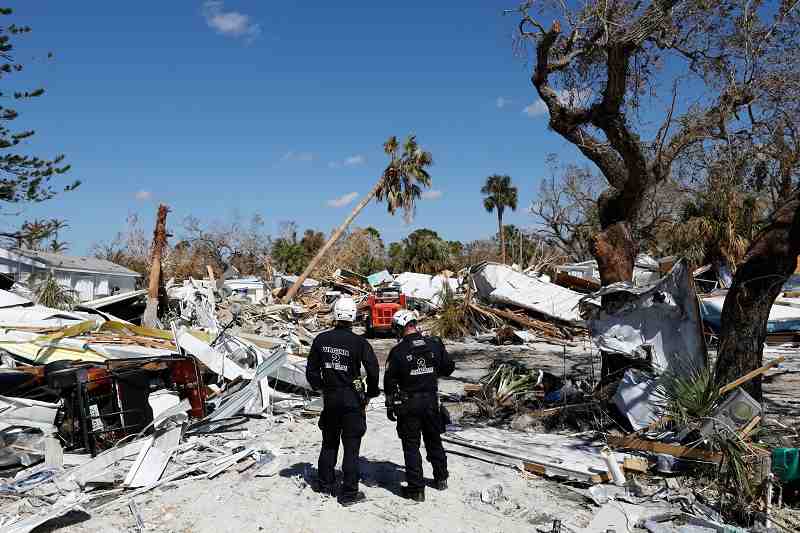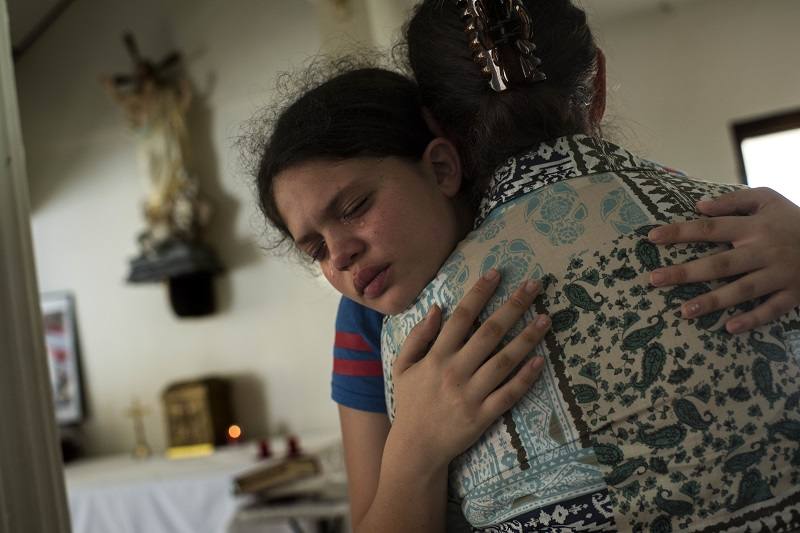Hurricane deaths have fallen over time, but Ian was a setback

Search-and-rescue personnel in Fort Myers Beach, Fla., on Oct. 5, 2022, in the aftermath of Hurricane Ian
13:52 JST, October 7, 2022
The Galveston hurricane of 1900, the deadliest natural disaster in U.S. history, crashed ashore much like Hurricane Ian did last week. As a large Category 4 with 150 mph winds, it shoved Gulf of Mexico waters deep into the booming Texas port city.
Seven feet above sea level, Galveston was steamrolled by an ocean surge nobody saw coming, taking 10,000 lives – about one quarter of its population at the time.
The tragedy of 122 years ago was repeated, to an extent, several times in the late 19th and early 20th centuries. Just one year before Galveston’s disaster, extreme wind and rain associated with a Puerto Rico hurricane killed about 3,400 people. In 1893, a pair of storms with enormous surges killed 1,000 to 2,000 people, one in Georgia and the other in Louisiana. A 1928 hurricane killed more than 1,800 in Florida, its deadliest storm to date, when a devastating surge spread from Lake Okeechobee into surrounding areas.
Deaths associated with hurricanes have generally declined since that era because of improved predictions and warning systems. But storms such as Hurricane Katrina in 2005 and now Ian – probably Florida’s deadliest since 1935 – show that our coasts remain perilously vulnerable.
Statistics from the National Hurricane Center show that the overwhelming majority of the deadliest U.S. hurricanes in history occurred before 1960, even as more people move to the Gulf and Atlantic coastlines every year. When the 1928 hurricane struck Florida, for example, it had a population of around 1.5 million. Today, more than 21 million people live there.
Walker Ashley, a professor at Northern Illinois University who researches weather and natural disasters, wrote in an email that the monitoring, detection and forecasting of storms is a “scientific revolution that has saved countless lives.”
Ashley also credited stronger building codes and evacuation coordination between federal and local authorities for keeping people out of harm’s way.
Still, numerous 21st-century hurricanes have caused dozens of deaths. A short list of storms – Ike, Sandy, Katrina, Maria and now probably Ian – have killed more than 100 people each. Drowning due to storm surge caused the majority of the fatalities in these storms, although most of the nearly 3,000 deaths in Maria were related to power outages induced by wind.

Nahir Ortiz, 14, cries in her grandmother’s arms at the family’s church in the hurricane-ravaged town of Caonillas, Puerto Rico, on Oct. 1, 2017. The Ortiz family’s house was destroyed by a mudslide. Puerto Rico was hit by two hurricanes, Irma and Maria, in September 2017.
– Ike made landfall on Texas’s Galveston Island in 2008, the same strip of land decimated a century before. The storm pushed a surge as high as 17.5 feet into populous nooks of the Texas and Louisiana coasts, killing 112.
– Sandy, like Ike, produced a towering surge as high as 12.5 feet, this time along the populous Northeast coast. The inundations took a heavy toll: 147 people died.
– Katrina produced a surge of 25 to 28 feet, its turbid floodwaters overtaking levees and engulfing entire swaths of coastal Louisiana and Mississippi, leaving behind 1,833 dead.
State authorities have confirmed 89 deaths from Ian in Florida, while the count from county sheriffs is at least 117, more than the number of fatalities from hurricanes Irma in 2017 and Andrew in 1992.
Why, if forecasters are better than ever at predicting hurricanes, have these storms taken such tolls?
“We’ve often put faith in technology and infrastructure to ‘save us’ in these events when, in reality, we need to remove the potential for that hazard to kill us,” Ashley said.
For the tolls of these storms to decline, hurricane-prone residents need to act on warnings, heed evacuation orders or not inhabit areas vulnerable to flooding.
But forecasts aren’t perfect, and warnings are not always understood or received by the people most at risk. Some people refuse or are not able to evacuate for many complicated reasons. And many hurricane-prone, low-lying coastal areas are among the nation’s most attractive for real estate development.
Ashley stressed that the important story of Ian will not be the number of lives lost, tragic as the final count will surely be.
“There are thousands of folks who survived this immense and powerful hurricane by seeking shelter and/or evacuating,” Ashley said. “While much work remains to be done, there are a lot of positives in a system that we take for granted.”





